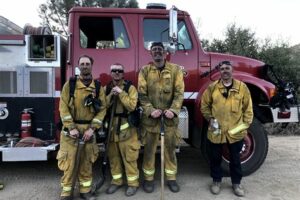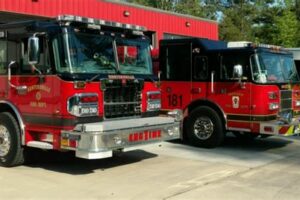Table of Contents
If you are passionate about protecting the environment and want to contribute to the fight against forest fires, learn how to volunteer and make a difference. Discover ways to get involved, gain relevant skills, and join dedicated teams working to prevent and combat wildfires.
Are you ready to make a difference and protect our planet’s precious forests? If you have ever wondered how you can contribute to the fight against devastating forest fires, then look no further. In this guide, we will explore step-by-step how you can become a volunteer firefighter and lend your skills and dedication towards preserving and safeguarding our natural landscapes. So, roll up your sleeves, grab your gear, and get ready to embark on a thrilling journey that involves bravery, teamwork, and a deep passion for environmental conservation.
How to Volunteer to Fight Forest Fires
Forest fires pose a serious threat to our environment, wildlife, and communities. The brave firefighters who combat these blazes often need support from volunteers to effectively contain and extinguish the flames. If you’re passionate about protecting nature and want to make a difference, volunteering to fight forest fires can be a rewarding experience. Here’s how you can get involved:
1. Research Local Fire Departments and Organizations
The first step in becoming a volunteer firefighter is to research local fire departments and organizations that actively work on forest fire suppression. Look for agencies such as state or national parks, wildlife management departments, or non-profit organizations dedicated to firefighting efforts. Find out their requirements for volunteers and any necessary training.
2. Understand the Risks and Physical Demands
Fighting forest fires is physically and mentally demanding work. It’s important to understand the risks involved and ensure you are physically fit to handle the challenges. This work requires stamina, strength, and the ability to withstand harsh environmental conditions. Be prepared for long hours, extreme heat, heavy smoke, and potentially dangerous situations.
3. Complete Required Training
Before joining a firefighting team, you will need to undergo mandatory training. This training usually covers fire behavior, safety protocols, equipment usage, and basic firefighting techniques. Contact your chosen organization or fire department to inquire about the training process, including any certifications or courses you need to complete.
4. Obtain the Necessary Certifications
Depending on your location and the type of firefighting you wish to participate in, specific certifications may be required. These can include qualifications such as First Aid and CPR, chainsaw operation, or wildland firefighter training. Ensure you meet all prerequisites and obtain the necessary certifications before applying as a volunteer firefighter.
5. Volunteer at Local Fire Camps
One way to gain experience and make connections in the firefighting community is to volunteer at local fire camps. These camps provide support and supplies to firefighters during extended operations. Volunteering at these camps offers an opportunity to observe professionals in action, learn from experienced firefighters, and demonstrate your commitment to the cause.
6. Join Community Firewise Programs
Community Firewise programs aim to educate residents about fire safety and prevention. By joining these initiatives, you can contribute to reducing the risk of forest fires in your community. Participate in activities such as clearing brush, creating defensible space around homes, and organizing fire drills. Your involvement will enhance your knowledge of fire prevention strategies and make you a valuable asset in future firefighting efforts.
7. Support Firefighters with Supplies and Resources
Even if you’re unable to participate directly in firefighting operations, you can still make a difference by providing support. Many organizations accept donations of supplies like non-perishable food, water, personal protective equipment, and camping gear. Additionally, fundraising efforts can help purchase essential resources for firefighters, such as communication systems, emergency tools, and first aid kits.
8. Stay Informed about Fire Activity
Being aware of fire activity in your region is important for both personal safety and staying informed about volunteering opportunities. Follow local news outlets, fire department websites, and social media accounts to receive updates on current fires, evacuation notices, and volunteering needs. This knowledge will allow you to respond promptly and be of assistance when required.
9. Participate in Fire Prevention Campaigns
Preventing forest fires is just as crucial as fighting them. Engage in fire prevention campaigns to raise awareness about responsible behavior in fire-prone areas. Share information on proper campfire practices, the dangers of discarded cigarettes, and the importance of reporting suspicious activities. By actively participating in prevention efforts, you can potentially prevent devastating fires from occurring in the first place.
10. Advocate for Forest Fire Policies
Advocacy plays a significant role in shaping forest fire policies and ensuring adequate resources are allocated for firefighting efforts. Get involved in local and national conversations about forest fire management, attend public hearings, and support organizations dedicated to promoting effective policies. By lending your voice to this cause, you can drive change and support firefighters on a broader scale.
Volunteering to fight forest fires is an honorable endeavor that requires dedication, training, and a passion for protecting our natural landscapes. By following these steps, you can contribute to the crucial work of preventing and combating these destructive blazes. Remember, always prioritize your safety and follow the guidance of experienced professionals when volunteering in any firefighting capacity.
A Complete Guide on How to Volunteer to Fight Forest Fires
Volunteering to fight forest fires plays a crucial role in protecting our natural environment and ensuring the safety of local communities. By understanding the importance of volunteering, individuals can fully grasp the gravity of this noble endeavor.
Understanding the Importance of Volunteering in Forest Fire Suppression
Forest fires pose a significant threat to our environment and communities. They destroy valuable natural resources, wildlife habitats, and put human lives at risk. Volunteering to fight forest fires is a selfless act that helps protect our forests, preserve biodiversity, and safeguard the well-being of local residents.
Researching and Contacting Local Fire Departments or Organizations
The first step in becoming a volunteer firefighter is to research and identify local fire departments or organizations that specialize in forest fire suppression. These entities are equipped with the expertise, resources, and infrastructure necessary to combat wildfires effectively. Once identified, reaching out to them directly allows for a clearer understanding of their requirements and how to get involved.
Assessing Personal Physical Fitness and Mental Preparedness
Working as a volunteer firefighter requires a significant level of physical fitness and mental fortitude. It is important to assess one’s own capabilities honestly, realizing the rigorous demands of firefighting, such as carrying heavy equipment and working in extreme conditions. Regular exercise, maintaining a healthy lifestyle, and cultivating a resilient mindset are essential preparations for this challenging role.
Completing Basic Firefighter Training and Certifications
Before embarking on any firefighting activities, it is crucial to complete basic firefighter training and obtain necessary certifications. These training programs equip volunteers with the essential knowledge and skills required to safely and effectively combat forest fires. Basic training typically covers topics such as fire behavior, equipment operation, first aid, and communication protocols.
Participating in Wildland Firefighter Preparatory Programs
Many organizations offer specialized programs catered specifically to training individuals as wildland firefighters. These preparatory programs provide hands-on experience and foster a deeper understanding of fire behavior and suppression techniques. Participants learn how to operate firefighting equipment, assess fire risks, and coordinate with other team members effectively.
Practicing Fire Safety and Prevention Measures
In addition to firefighting, an important aspect of volunteering to fight forest fires involves fire safety and prevention. Learning about fire safety measures, understanding fire behavior, and promoting awareness within local communities ensures proactive measures are taken to prevent wildfires. This includes educating others about proper campfire usage, maintaining clear defensible spaces around homes, and reporting potential fire hazards promptly.
Joining Volunteer Firefighter Brigades or Community Action Groups
Volunteer firefighter brigades and community action groups provide a platform for individuals to contribute effectively to forest fire suppression efforts. Joining such organizations allows individuals to work closely with experienced firefighters and actively participate in combating wildfires. These groups often organize drills, training sessions, and community outreach programs to enhance preparedness and response capabilities.
Building a Network and Engaging in Continuous Learning
Volunteering to fight forest fires is a continuous learning process, and building a network of fellow volunteers and firefighters can provide invaluable support and guidance. Engaging in regular training sessions and workshops helps enhance firefighting skills and keeps volunteers up-to-date with the latest techniques and strategies. Additionally, participating in conferences and seminars related to wildfire management allows individuals to exchange knowledge and stay informed about emerging trends in the field.
By following these guidelines, individuals can actively contribute to forest fire suppression efforts and make a significant impact in protecting our environment and communities. Volunteering to fight forest fires is not only a noble endeavor but also a vital responsibility that helps ensure the preservation of our natural resources for future generations.
How to Volunteer to Fight Forest Fires: A Guide for Aspiring Heroes
As wildfires continue to ravage our forests, leaving a trail of destruction in their wake, the need for brave individuals willing to volunteer and fight these fires has never been greater. If you are one of those fearless souls yearning to make a difference and protect our precious natural resources, here is a comprehensive guide on how to volunteer to fight forest fires:
- Educate Yourself: Before embarking on this noble endeavor, it is essential to educate yourself about the nature of forest fires, their behavior, and the risks involved. Take the time to research firefighting techniques, safety protocols, and familiarize yourself with the tools and equipment used during fire suppression efforts.
- Physical Fitness: Fighting forest fires is an arduous task that demands exceptional physical fitness. Engage in regular exercise routines to build stamina, strength, and endurance. Consider activities such as hiking, running, weightlifting, and cardio exercises to prepare your body for the demanding challenges that lie ahead.
- Training Programs: Seek out local training programs offered by firefighting agencies or organizations. These programs provide invaluable knowledge and hands-on experience in dealing with forest fires. Look for courses that cover fire behavior, containment strategies, communications, and first aid. Completing such training will enhance your skills and increase your chances of being selected as a volunteer firefighter.
- Join Volunteer Fire Departments: Local fire departments often have volunteer divisions that actively participate in fire suppression efforts. Reach out to your nearest fire station and inquire about opportunities to join as a volunteer firefighter. By becoming part of a team, you will gain practical experience, receive further training, and work alongside seasoned professionals.
- Community Organizations: Numerous community organizations and non-profit groups collaborate with firefighting agencies to combat forest fires. Joining these organizations can provide you with additional volunteer opportunities, as they often assist with logistics, support services, and fundraising efforts. Participating in their activities will allow you to contribute to the cause while learning from experienced individuals.
- Stay Informed: Keep yourself updated on fire emergencies in your region by following local news outlets and subscribing to emergency alert systems. Being aware of current fire situations will enable you to respond promptly when assistance is required.
- Equipment and Gear: Invest in personal protective gear such as fire-resistant clothing, boots, gloves, and a helmet. Additionally, consider purchasing firefighting tools like shovels, axes, and hoses to supplement your firefighting arsenal. Remember, safety should always be a top priority.
- Network and Volunteer: Attend fire-related seminars, workshops, and conferences to network with professionals in the field. By actively engaging with the firefighting community, you might discover additional volunteer opportunities or gain insights that can further refine your skills and knowledge.
- Emergency Response Training: Enroll in first aid and emergency response training courses offered by recognized organizations. These skills are invaluable during firefighting operations, as accidents or injuries can occur at any moment. Being prepared to handle medical emergencies demonstrates your commitment to the cause and enhances your suitability as a volunteer firefighter.
- Be Patient: Volunteering to fight forest fires requires patience and perseverance. Opportunities may not arise immediately, as firefighting agencies prioritize trained professionals for hazardous situations. However, by continuously improving your skills, networking, and showing dedication, your chance to make a difference will eventually come.
Remember, volunteering to fight forest fires is a noble calling that demands courage, selflessness, and an unwavering commitment to protecting our environment. By following these steps, you are taking the first stride towards becoming a true hero in the battle against these devastating infernos.
Thank you for visiting our blog and taking the time to learn about how you can volunteer to fight forest fires. As we all know, forest fires pose a significant threat to our environment, wildlife, and communities. It is crucial that we come together and take action to protect and preserve our forests. In this closing message, we will provide you with some final thoughts and resources to help you get started on your journey as a forest fire volunteer.
Firstly, it is important to recognize that volunteering to fight forest fires requires dedication, training, and a strong commitment to safety. Before embarking on this path, it is essential to familiarize yourself with the risks and challenges associated with firefighting. It is not a task to be taken lightly, but with the right skills and knowledge, you can make a significant difference in preventing and controlling forest fires.
One of the most effective ways to get involved as a forest fire volunteer is to join an established organization or agency that specializes in wildfire management. These organizations provide comprehensive training programs that equip volunteers with the necessary skills and knowledge to safely and effectively combat forest fires. Some well-known organizations include the U.S. Forest Service, National Park Service, and local fire departments. Reach out to these organizations to inquire about their volunteer opportunities and training programs.
In addition to joining established organizations, you may also consider participating in community-based initiatives aimed at preventing forest fires. These initiatives often involve educating the public about fire safety, conducting controlled burns to reduce fuel loads, and maintaining fire breaks. By engaging with your local community, you can contribute to the long-term prevention and mitigation of forest fires.
In conclusion, volunteering to fight forest fires is a noble and vital endeavor. The destruction caused by these fires can have far-reaching consequences, affecting not only our natural environment but also the lives of countless individuals. By becoming a forest fire volunteer, you can play an active role in protecting our forests and ensuring the safety of our communities. Remember to prioritize safety and seek proper training before engaging in any firefighting activities. Together, we can make a difference and preserve the beauty and ecological balance of our forests for future generations.
Thank you once again for visiting our blog, and we hope that the information provided has inspired you to take action. Stay safe, stay informed, and join the fight against forest fires!
.
As a journalist, it is important to address the common questions that people have about volunteering to fight forest fires. Here are some frequently asked questions along with detailed answers:
How can I volunteer to fight forest fires?
Volunteering to fight forest fires requires proper training and qualifications. The best way to get involved is to contact your local fire department or forestry agency. They can provide information on volunteer programs, training opportunities, and eligibility criteria.
What kind of training is necessary to become a volunteer firefighter?
Training requirements vary depending on the region and the specific role you wish to undertake. Generally, volunteers are required to complete courses in basic fire safety, fire behavior, equipment operation, and first aid. Additionally, physical fitness assessments may be conducted to ensure you can handle the demands of firefighting.
Are there any age or physical requirements to volunteer as a firefighter?
Age and physical requirements differ among organizations and jurisdictions. In many cases, volunteers must be at least 18 years old and in good physical condition. However, some programs may have opportunities for younger volunteers or those with varying levels of physical abilities. It is best to inquire directly with the relevant authorities to understand their specific requirements.
Can I volunteer if I don’t have any previous firefighting experience?
Absolutely! Many volunteer firefighter programs are designed for individuals without prior experience. They provide comprehensive training to equip you with the necessary skills and knowledge. The key is to show enthusiasm, dedication, and a willingness to learn.
What are the risks involved in volunteering to fight forest fires?
Volunteering as a firefighter, particularly in forest fire situations, can be physically and mentally demanding. It involves working in challenging environments with potential exposure to smoke, extreme heat, and hazardous terrain. However, with proper training, safety protocols, and teamwork, the risks can be minimized. It is crucial to follow instructions provided by experienced firefighters and prioritize your well-being.
Can I volunteer for a specific period or do I need to commit long-term?
Volunteer firefighting opportunities can vary in terms of duration. Some programs may allow individuals to volunteer for shorter periods, such as during peak fire seasons, while others may require a more extended commitment. It is advisable to discuss your availability and preferences with the local fire department or agency to find an arrangement that suits both parties.
Remember, becoming a volunteer firefighter to fight forest fires is a noble endeavor, but it requires dedication, training, and a genuine passion for public service. By reaching out to the appropriate authorities and following the necessary steps, you can contribute to protecting our forests and communities from the devastating effects of wildfires.






